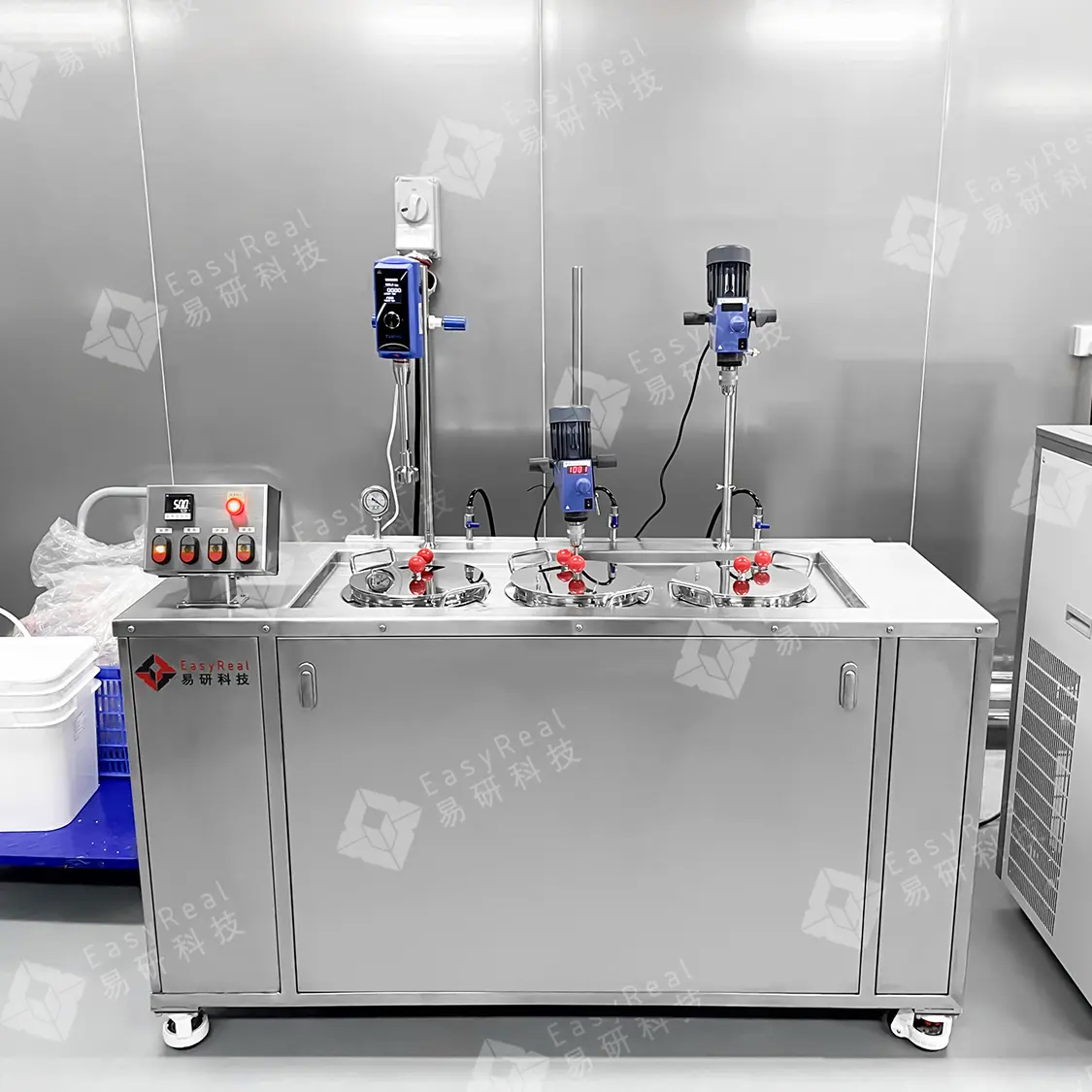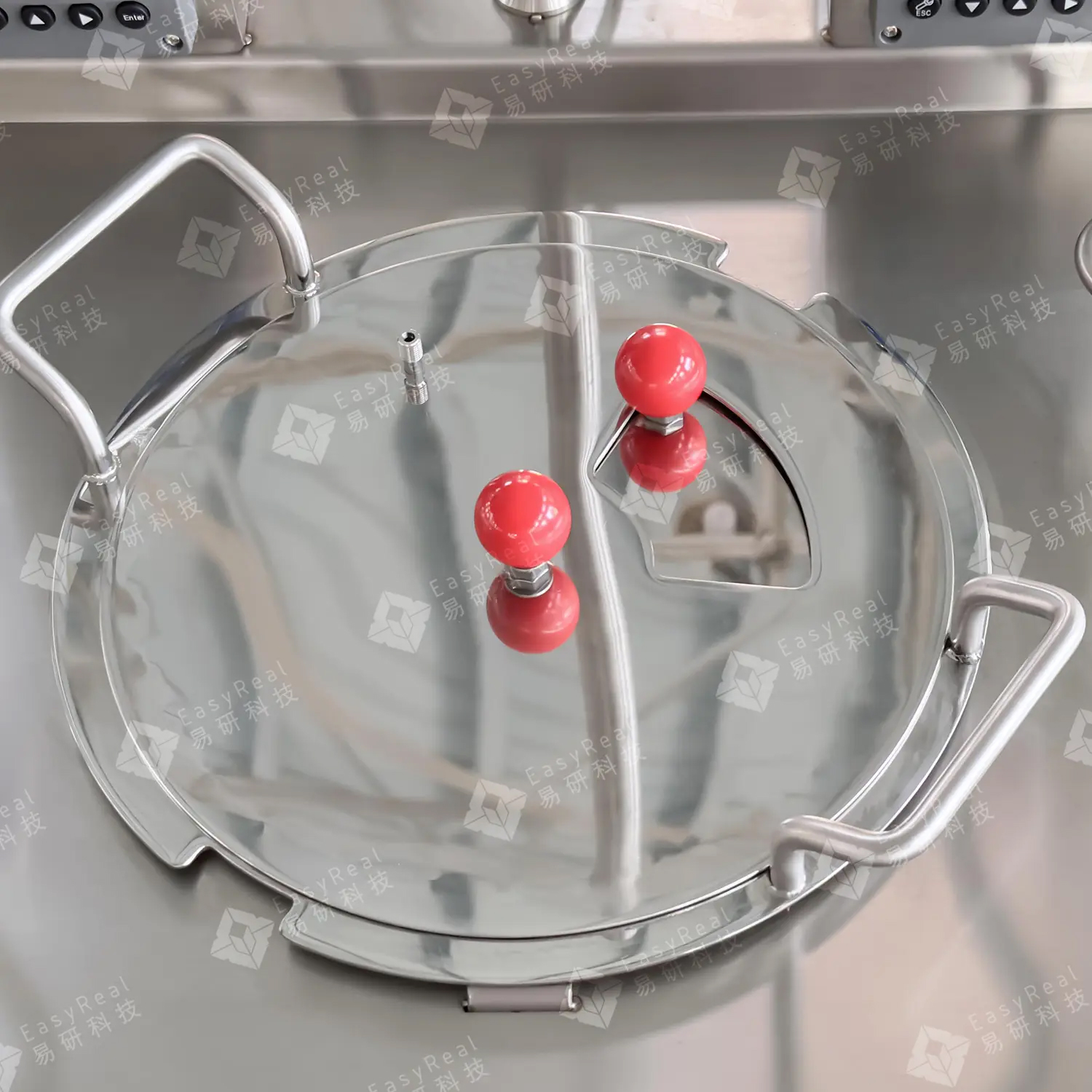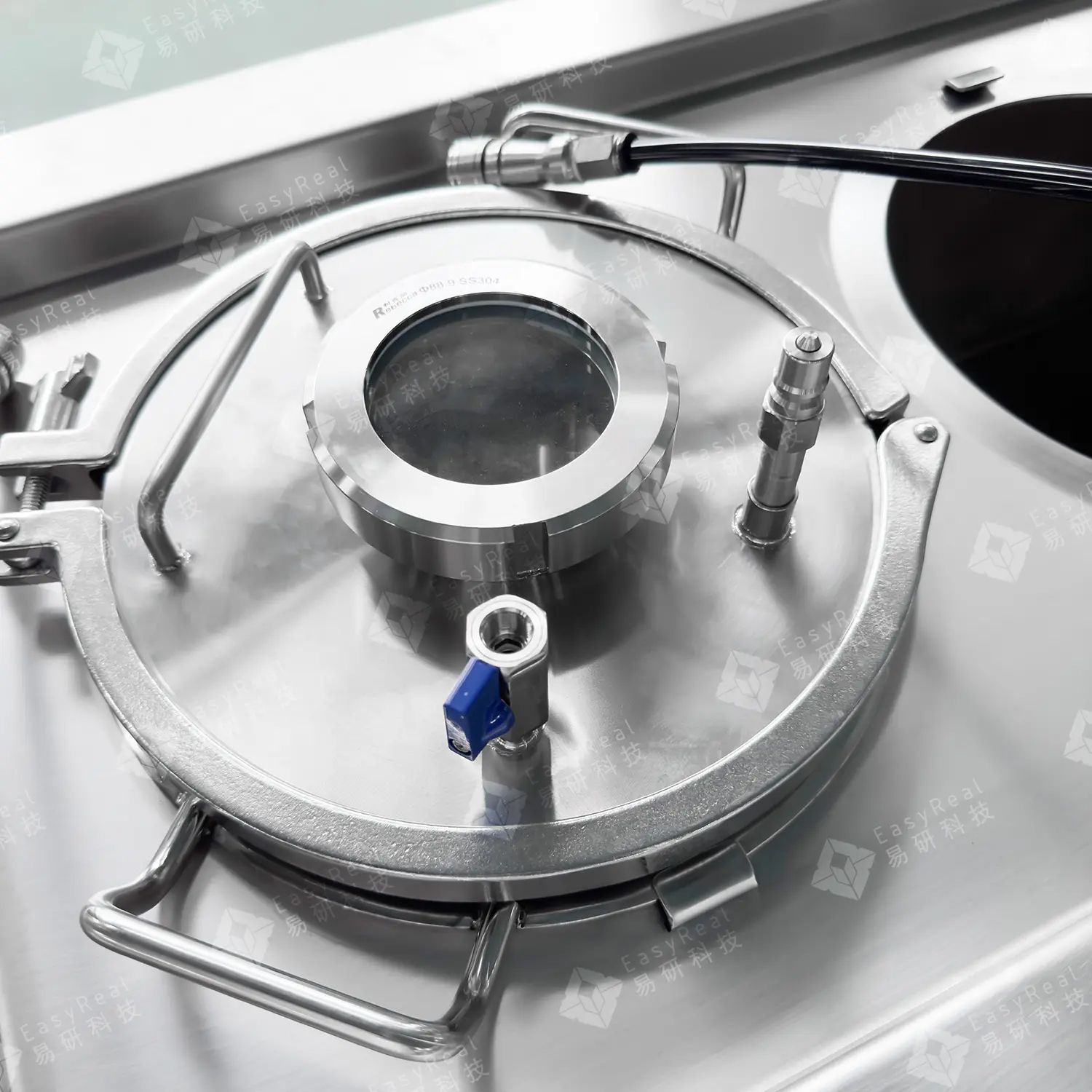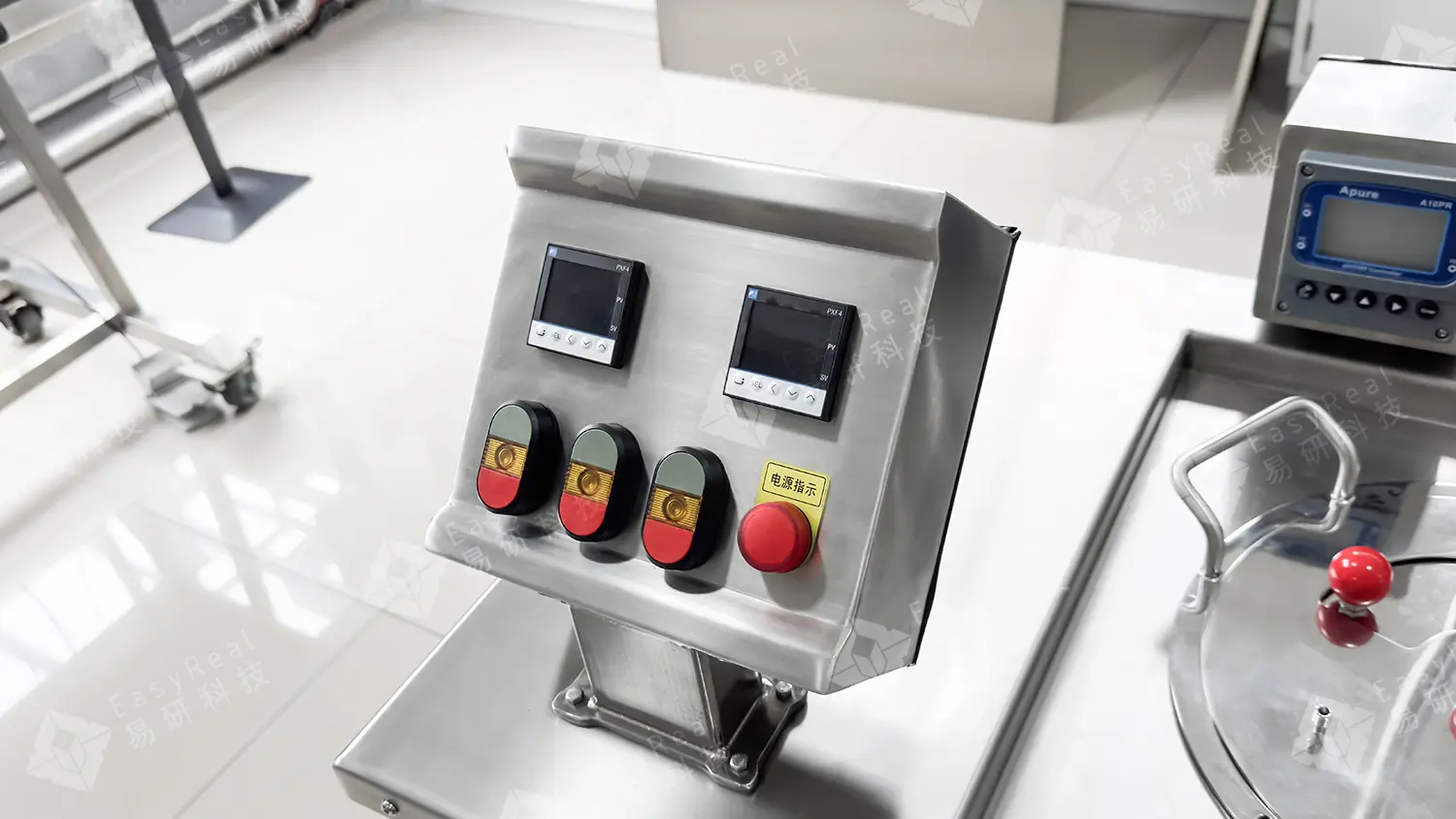

The Water Bath Blending Vessel from EasyReal is a versatile mixing solution built for liquid food, dairy, and beverage processing. It uses a water bath system to gently and precisely heat ingredients while stirring, ensuring uniform results without overheating.
This vessel is perfect for temperature-sensitive products such as milk-based drinks, plant-based beverages, soups, fruit juices, or functional nutrition formulas. It’s commonly used in R&D centers, pilot plants, and small-scale batch production facilities.
The integrated stirring system and PID-controlled heating ensure stable operation, repeatable results, and excellent product quality. Whether you're preparing prototypes, running stability tests, or developing new formulas, this blending vessel helps you achieve accurate results efficiently and safely.
Description of EasyReal Water Bath Blending Vessel
The EasyReal Water Bath Blending Vessel offers a smart and safe way to mix, heat, and hold fluid materials without the risk of burning or degrading sensitive ingredients.
This system uses an outer water jacket heated by electric or steam sources. Heat transfers gradually to the product, which prevents hotspots and keeps delicate compounds safe. The tank includes an adjustable-speed agitator to mix the liquid gently and consistently.
Users can set the desired product temperature with high precision. The system responds in real-time, holding a stable temperature to support fermentation, pasteurization, or simple blending tasks.
The design also includes a hygienic bottom outlet, stainless steel frame, level indicator, and digital temperature controls. It’s ready to run as a standalone unit or as part of a larger processing line.
Compared to direct-heated vessels, this model protects the natural taste, nutrients, and viscosity of foods. It’s especially effective for R&D work and semi-industrial testing where quality matters more than volume.
Application Scenarios of EasyReal Water Bath Blending Vessel
You can use the Water Bath Blending Vessel in many industries. It is widely adopted by food factories, beverage producers, dairy processors, and academic laboratories.
In dairy, the vessel supports the mixing and gentle heating of milk, yogurt bases, cream formulations, and cheese slurries. It prevents scorching and helps control microbial activity.
In fruit juice and plant-based beverage sectors, it mixes ingredients like mango pulp, coconut water, oat base, or vegetable extracts. The gentle heat helps retain natural flavors and colors.
Food R&D labs use this system to test recipes, evaluate heat behavior, and simulate commercial production steps. It’s also suitable for producing soups, broths, sauces, and liquid nutritional products that require low-shear agitation and accurate thermal control.
Pharma-grade facilities and functional food developers also use the vessel to handle blends containing probiotics, vitamins, enzymes, or other heat-sensitive ingredients.
Water Bath Requires Specialized Processing Lines
Unlike standard mixing tanks, the Water Bath Blending Vessel must maintain strict control over heating curves and mixing uniformity. Some raw materials, especially in wet waste, organic extracts, or milk-based foods, are very sensitive to temperature changes.
If heat is too direct, it causes protein coagulation, texture breakdown, or flavor loss. If mixing is uneven, it leads to product inconsistency or microbial hotspots. That’s why a water bath system works better. It heats the outer layer of water, which then surrounds the mixing tank. This creates a gentle thermal envelope.
When processing food waste-derived bases, like liquid feed or organic slurry from fruit/vegetable leftovers, this vessel helps stabilize the mixture and eliminate bacteria without cooking it.
For high-sugar or viscous mixtures (like syrup or pulp blends), the system ensures uniform heat transfer without sticking or caramelizing. It is also ideal for batch-to-batch consistency during lab testing or small-batch commercialization.
Flow Chart of Water Bath Blending Vessel Processing Steps
Here’s a typical flow for how this vessel works in a lab or pilot plant:
1. Preheating (if needed) – Optional preheat in a buffer tank or inline heater.
2. Raw Liquid Feeding – Pour in the base material (milk, juice, slurry, or feedstock).
3. Water Bath Heating – Start water heating to reach target product temperature (30–90°C).
4. Agitation & Blending – Continuous low-shear mixing ensures uniform heating and distribution.
5. Optional Pasteurization or Fermentation – Hold at specific time-temperature combinations to stabilize or culture the mix.
6. Sampling & Monitoring – Take readings, test pH, log data.
7. Discharge & Next Step – Move blended product to filler, holding tank, or secondary treatment (e.g., sterilizer, homogenizer).
Key Equipment in the Water Bath Blending Vessel Line
① Water Bath Blending Vessel
This is the core unit. It includes a stainless steel tank, where hot water flows through the outer shell to heat the product gently. The inner chamber holds the liquid food. A variable-speed agitator mixes the contents without introducing air. The vessel has an integrated electric or steam heater, digital temperature controller, safety pressure valve, and drain valve. Its key advantage is even heat transfer with no scorching, perfect for dairy, fruit-based liquids, or lab fermentations.
② Precision Temperature Controller (PID Panel)
This control box uses PID logic to monitor product temperature in real time. It adjusts the heating rate automatically. Users can set precise temperature ranges (e.g., 37°C for fermentation or 85°C for pasteurization). This keeps the product stable and avoids overheating fragile compounds like probiotics or enzymes.
③ Electric or Steam Heating Unit
For standalone models, an electric heating coil circulates hot water around the tank. For industrial settings, a steam inlet valve connects to central steam supply. Both systems feature overheat protection, thermal insulation, and energy-saving cycles. EasyReal offers options to switch between modes depending on local infrastructure.
④ Agitation System with Adjustable Speed
The agitator includes top-mounted motor, shaft, and sanitary-grade paddles. Users can adjust the mixing speed to fit the viscosity of the product. This prevents dead zones and supports homogeneous mixing of pulp, powder, or nutrient-rich formulas. Special blades are available for high-fiber or grain-based slurries.
⑤ Sampling & CIP Nozzles
Each tank includes a sampling valve and optional clean-in-place (CIP) nozzle. This makes it easy to collect test samples or rinse the tank automatically with hot water or detergent. The hygienic design reduces contamination risks and shortens cleaning downtime.
⑥ Optional pH and Pressure Sensors
Add-ons include real-time pH monitors, pressure gauges, or foam sensors. These help track fermentation status, chemical reaction points, or unwanted foaming during heating. Data can be shown on screen or exported to USB for analysis.



Material Adaptability & Output Flexibility
The Water Bath Blending Vessel works with a wide range of materials. This includes dairy, fruit juice, vegetable slurry, plant-based liquids, and even wet organic waste streams.
For dairy, it processes milk, yogurt base, and cream blends without burning proteins. For juice and functional drinks, it helps mix pulp and water-soluble compounds without settling. For kitchen waste slurries used in fertilizer or feed, the tank maintains biological activity while killing pathogens with low-temperature heat.
You can switch easily between different batches or recipes. Cleaning is fast. That means one vessel can run multiple projects in a day—like juice testing in the morning and fermented soup trials in the afternoon.
The output forms depend on downstream systems. For example:
• Connect to aseptic filler to bottle clean juice.
• Pipe to evaporator for thickening.
• Move to homogenizer for smoother texture.
• Send to fermentation cabinet for probiotic drinks.
Whether your goal is high-protein oat drink, enzyme-rich plant milk, or stabilized waste feedstock, this vessel fits the job.
Ready to Build Your Water Bath Blending Vessel Processing Line?
If you’re working on new beverage recipes, nutritional products, or food waste-to-feed projects, this vessel gives you the precision and control to succeed.
EasyReal has delivered blending vessels to more than 30 countries. Our clients range from startup food labs to national R&D institutes. Each one received custom layout designs, user training, and after-sales support.
We build every system from scratch—tailored to your ingredients, production goals, and site layout. That’s how we ensure better ROI, fewer quality issues, and smoother operations.
Contact us today to talk with our engineers.
Let’s design your next pilot line.
With EasyReal, building the right system is easier than you think.
Post time: Jul-14-2025

